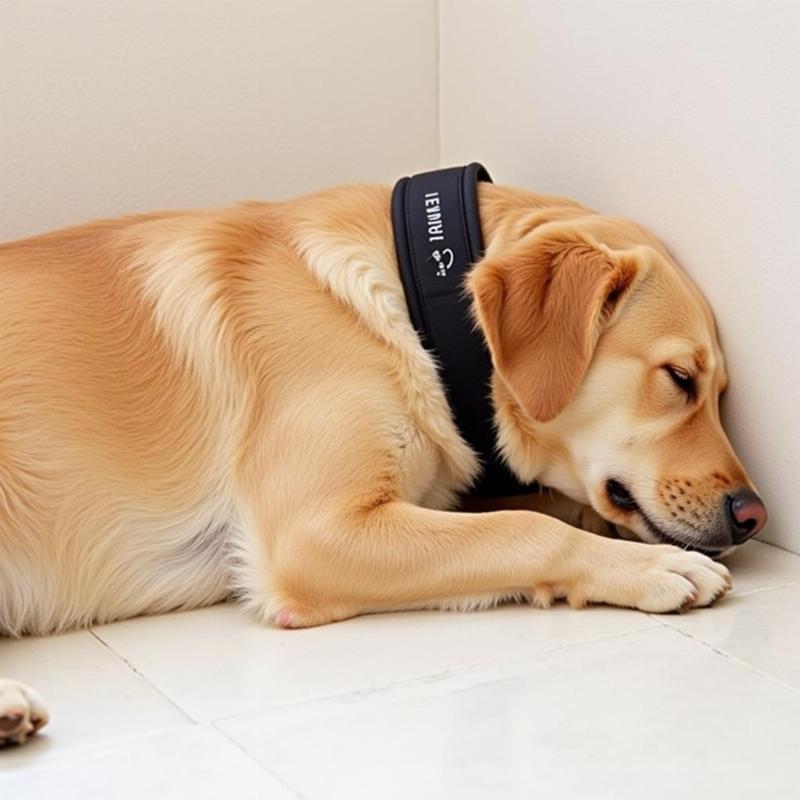Anti-lick strips for dogs are becoming a common tool for pet owners dealing with excessive licking, especially after surgeries or injuries. Understanding their purpose, proper application, and potential alternatives is crucial for ensuring your furry friend’s well-being. This comprehensive guide will delve into everything you need to know about anti-lick strips for dogs in the US.
Understanding the Need for Anti-Lick Strips
Why would a dog owner consider anti-lick strips? Excessive licking can disrupt the healing process, introduce infection, and even cause further damage to wounds or surgical sites. While licking is a natural instinct for dogs, it can be detrimental in certain situations. Anti-lick strips offer a physical barrier, preventing the dog from accessing the affected area.
Choosing the Right Anti-Lick Strip
Several types of anti-lick strips are available in the US market, each with its pros and cons. Inflatable collars, often referred to as “the cone of shame,” are a common option, but can restrict a dog’s vision and movement. Soft cones made from fabric or foam offer more comfort but may be less effective for determined lickers. Anti-lick strips, which attach around a dog’s leg or neck, provide a more targeted approach, allowing for greater freedom of movement while still protecting the wound. Consider your dog’s size, temperament, and the location of the injury when making your selection.
Applying Anti-Lick Strips Correctly
Proper application is essential for the effectiveness of anti-lick strips. Ensure the strip is snug but not too tight, allowing for two fingers to fit comfortably between the strip and your dog’s skin. The wound should be covered with a bandage before applying the strip. Monitor the area regularly for any signs of irritation or swelling.
Alternatives to Anti-Lick Strips
While anti-lick strips are often effective, other options are worth exploring. Surgical recovery suits can be a good alternative for larger areas or for dogs who are particularly adept at removing strips. Bitter sprays can deter licking by making the area taste unpleasant. Consult with your veterinarian to determine the best approach for your dog’s specific needs.
Are Anti-Lick Strips Safe?
When used correctly, anti-lick strips are generally safe. However, improper application can lead to skin irritation, chafing, or even restricted blood flow. Always follow the manufacturer’s instructions and monitor your dog closely for any signs of discomfort. If you notice any issues, consult your veterinarian.
 A dog wearing an anti-lick strip comfortably while sleeping.
A dog wearing an anti-lick strip comfortably while sleeping.
When to Consult Your Veterinarian
If your dog’s excessive licking persists despite the use of anti-lick strips, or if the wound shows signs of infection, it’s crucial to consult your veterinarian. They can determine the underlying cause of the licking and recommend appropriate treatment options.
Conclusion
Anti-lick strips for dogs can be a valuable tool in managing excessive licking and promoting healing. By understanding their purpose, proper application, and potential alternatives, you can ensure your furry friend receives the best possible care. Remember, always consult with your veterinarian for personalized advice tailored to your dog’s individual needs. Using anti-lick strips responsibly can contribute significantly to a comfortable and speedy recovery for your pet.
FAQ
- How long should my dog wear an anti-lick strip? This depends on the nature of the injury and your veterinarian’s recommendations. Generally, it’s best to keep the strip on until the wound is fully healed.
- Can anti-lick strips be used for hot spots? Yes, anti-lick strips can help prevent further irritation and promote healing of hot spots.
- What should I do if my dog keeps trying to remove the anti-lick strip? You may need to try a different type of strip or consider alternative options like a recovery suit or bitter spray. Consult with your veterinarian.
- Are there different sizes of anti-lick strips? Yes, anti-lick strips come in various sizes to accommodate different breeds and sizes of dogs.
- Can I make a homemade anti-lick strip? While some pet owners attempt this, it’s generally recommended to use commercially available strips to ensure proper fit and safety.
- How do I clean an anti-lick strip? Follow the manufacturer’s instructions for cleaning. Most strips can be wiped down with a damp cloth.
- My dog seems depressed while wearing the anti-lick strip. What should I do? Try to provide extra comfort and reassurance. If the behavior persists, consult your veterinarian.
Related Articles
About Beautdogs.us
Beautdogs.us is your premier resource for all things dog-related in the US. We offer expert advice on dog breeds, grooming, training, health, and overall well-being. From puppyhood to senior years, we provide comprehensive and trustworthy information for both new and experienced dog owners. Our goal is to help you navigate the joys and challenges of dog ownership, ensuring a happy and healthy life for your furry companion. Contact us for personalized support and guidance: Email: [email protected], Phone: +1 501-555-7529.